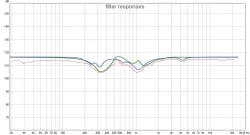Matt respect for winning IASCA! Thats what I have in mind maybe - one day. I really do understand all that you've said. but don't think I can explain what Im doing easily, not until I can prove it works. I only care about the drivers listening position at the moment.
I have a target curve and identical DIY response (all 0deg phase) for all my drivers including an overall target that when I want to tweak what I hear I go and redo these targets. measurements are always done with mic at drivers left ear and drivers right. The ones i use to judge what I hear to what I see is with all, or in this case just the mid range pair, of speakers playing, take the information received by the left ear and same with right ear then average. For me the better the info matches on both sides the better the image with regards to intensity. Timing these below 400hz is easy as there is only one center with regards to bass and this can't be EQd. So I use the mid target as a guide to cut the peaks from measurement made at Rear Rmid, Rear Lmid, Lear Lmid and Lear Rmid so they are just under the guide this way there is no peaks / resonances when they are playing together.
When you measure one speaker at one ear then measure the same speaker at the other ear obviously theres a difference if you apply EQ to it there will always be that proportionate amount of info received by the other, like a signature or footprint. I want that footprint to be a little less than the direct sound so you hear the from the intended direction and not the reflection. Sorry this is the best explanation I can give. I think maybe I have gone slightly mad but well done if you read this! These filters are what I want applied to one speaker and are from the direct sound and the reflected sound.
Thanks for the props, but...I should say I won a state championship. While I made it to Nationals, I didn't compete in enough total competitions to be competitive for the final national championship. If I recall correctly I placed 7th overall, but I never came in less than 2nd place in any single competition, I just didn't have enough points. I got out of it because I learned something. obviously, everyone who was competing at this level had sponsorships. You would need to be very wealthy otherwise. All of my equipment was cost or free and much of it was prototype odd-ball stuff. Officially I was part of Kicker competition, but I had Eclipse, Nakamichi, Dynaudio, and Veritas audio (I think they are now defunct). My last year of competition I gave up Kicker and took on Memphis audio instead. What I realized was that winning wasn't about anything more than having the most-best equipment and going to a lot of shows. It really wasn't about sound quality (which is what I cared about). By the end I was using DSP equalization using Dolby Lake processing and I could easily score perfect in most areas. I felt like I was cheating. I always got a perfect frequency response score because....I knew were the mic had to always go and I made a specific mode that measured perfect flat in that mic position.. It wasn't even close to the mode I listened in.
I'm afraid I still don't understand what you are doing though. How does a filter come from direct and reflected sound? Do you mean that is the shape of the filter you generated based on a measurement of both? In a car you always have direct and reflected and separating the two would be exceedingly difficult (given that the car is so small that the reflections are all generally under 5ms (other than those coming from the back of the car or opposite side).
When you say you are trying to increase the direct sound relative to reflected, are you trying to actively cancel the reflected sound somehow? Li,ke use the rear speakers to cancel reflections?
Could you post your response measurement MDAT files so I can maybe see what is going on? Maybe I can better understand the current issues.
I would need to see the total response of the left and right side. If it's just individual drivers it won't do me a lot of good.














